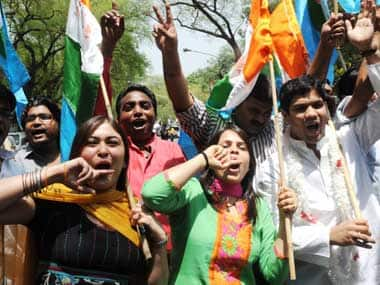Despite the explosion of political opinion by young Indians on the social media sites like Twitter, voter registration figures suggest when it comes to voting their numbers are nowhere near the volume of chatter they generate. Voter registration figures for Delhi reveal that online political engagement by young urban voters is yet translate into intention to vote. Only half of the first time voters in Delhi, says a Times of India report, are registered to vote. (Read full report here) Not an altogether surprising discovery, going by past trends. [caption id=“attachment_1237901” align=“alignleft” width=“380”]  Representational image. AFP[/caption] Sanjay Kumar, psephologist and professor at Centre for the Study of Developing Societies said,“We must realise that this (young people) is a mobile population. They are more mobile than voters of any other age group. The likelihood of them being in Delhi when electoral roll is being updated are slightly lower compared to other age groups." “Secondly, they take it more lightly. They don’t feel very strongly about being registered to vote, perhaps they feel they can get themselves registered at a later stage,” he said. On the other hand, in rural India, the registration rates among young people are higher, Kumar said. “You won’t find problems with registration in rural areas. If you look at voting patterns, it is much higher in rural areas. Several factors are responsible for this. For one, mobility is less compared to in urban areas. It is more likely that a young person will be in the village on election-day compared to in urban areas. In cities, many young people treat voting day as a holiday and go out,” he said. In Delhi, the voter turnout among young voters (age group 18 to 21) in the last election in was about 45-46 per cent, Kumar said. “It was about five–six per cent less than the average voter turnout in Delhi which was around 50 per cent.” Providing a social scientist’s perspective, Bhaskara Rao of the Centre for Media Studies says poor voter registration numbers among young Indians is a reflection of the ‘sense of alienation’ from ‘party politics’. “Since the last election, there is has been much more activity and participation of youth in politics. And yet they have not registered to vote. It shows the level of alienation they feel from the mainstream politics or party politics,” Rao said. And a key contributor to that sense of alienation, says Rao, is what he describes as ‘pre-emptive’ model of media coverage that tends make young voters feel that the outcome is pre-ordained and that his or her vote will not count. “The pre-emptive structure of reporting promotes bandwagaon votes. The value of individual vote is lost. That source of despair is one of the main reasons why I feel young voters feel alienated,” Rao said. What then explains burst of political activity on social media? “They are content with Twitter. That is a lonely activity, what I call an alienated activity. Activity on Twitter and social media is written about so much, talked about so much, but if you de-segregate the phenomena you will see that these are alienated opinions and not examples of networking. The social media is supposed to be a networking media but that is not what is happening when it comes to a phenomenon like voting,” Rao said. He added, “Eventually what matters is going out there and casting your vote. Engaging on twitter is not going to change the outcome.” The reason voting patterns are more encouraging when it comes to young rural voters is because they feel their lives are more affected by politics compared to their urban counterparts, said Rao. “They are more affected by politics. They feel by voting some hope is there for them,” he said.
Voter registration figures for Delhi reveal that online political engagement by young urban voters is yet translate into intention to vote.
Advertisement
End of Article


)
)
)
)
)
)
)
)
)



